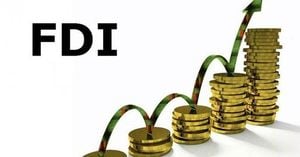The price of gold has once again captured investor attention, climbing sharply this week across South Asia. On April 5, 2025, the price of 24-carat gold in India rose by ₹1,850 per 10 grams, according to the India Bullion and Jewelers Association (IBJA). Just a week prior, on March 29, gold was priced at ₹89,164 per 10 grams, but by April 5, it had jumped to ₹91,014, reflecting heightened investor activity and macroeconomic triggers. This continues the upward trajectory observed since the start of 2025, with prices rising a total of ₹14,852 since January 1, when gold was priced at ₹76,162.
In stark contrast, silver prices saw a steep decline this week. After hitting an all-time high of ₹1,00,934 on March 28, silver fell to ₹92,910 per kg on April 5, a decrease of ₹7,982 in just one week. Nonetheless, silver has gained ₹6,895 since the beginning of the year, up from ₹86,017 per kg.
Experts attribute this week’s spike in gold prices to a combination of international and domestic economic factors. Here are the top four reasons driving this trend:
1. Geopolitical Tensions: With Donald Trump back in the spotlight as President of the United States, global geopolitical uncertainty has increased. Investors traditionally turn to gold as a safe-haven asset during periods of political unrest.
2. Weakening Rupee Against the Dollar: As the Indian rupee continues to depreciate against the US dollar, gold becomes more expensive to import. This currency impact directly inflates domestic gold prices.
3. Stock Market Volatility: The growing instability in stock markets—both domestic and global—is prompting investors to shift their funds into stable assets like gold. The metal’s consistent upward movement is reinforcing its appeal.
4. Rising Inflation Rates: Inflationary pressures are driving demand for tangible assets. As inflation rises, purchasing power erodes, and gold acts as a hedge, maintaining its value and attracting more buyers.
Gold touched an all-time high of ₹91,205 per 10 grams on April 3, just days before settling slightly lower at ₹91,014. Silver, meanwhile, had soared to ₹1,00,934 per kg on March 28 before the recent correction. Despite this week’s silver dip, analysts remain optimistic about its long-term prospects. The volatility in silver is seen as short-term and largely influenced by profit booking following its record peak.
Looking ahead, expert predictions for gold and silver in 2025 are optimistic. Ajay Kedia, Director at Kedia Advisory, predicts that gold’s rally is far from over. "Increasing geopolitical tension and growing investments in Gold ETFs are driving demand. Gold is likely to cross ₹94,000 per 10 grams by year-end," Kedia noted. Meanwhile, Anuj Gupta, Commodity & Currency Head at HDFC Securities, believes silver’s story is equally promising. "Silver could reach ₹1,08,000 per kg by the end of 2025, driven by industrial demand and global macro trends," he said.
The consistent surge in gold prices is a clear indicator of market sentiment turning risk-averse. As geopolitical events unfold and inflation continues to rise, gold and silver are expected to remain attractive asset classes for both retail and institutional investors. While prices are nearing record highs, experts suggest phased buying could be a prudent strategy for those looking to hedge their portfolios or invest long-term.
The week ending April 5, 2025, has proven pivotal for the precious metals market. Gold’s rise of ₹1,850 and silver’s correction of ₹7,982 reflect broader global trends and economic undercurrents. As analysts forecast further gains in both commodities, investors may find this an opportune moment to realign their investment strategies.
In Pakistan, gold prices are also experiencing fluctuations based on international market trends. On April 5, 2025, local gold markets and Sarafa Markets reported varying rates, which are influenced by global economic conditions.
Meanwhile, in Bangladesh, the situation mirrors that of its neighbors. On April 5, 2025, the Bangladesh Jewelers Association (BAJUS) announced an increase in local gold prices effective from March 29. The price of the highest quality 22-carat gold (11.664 grams) per bhori increased by 1,773 taka, from 1,56,099 taka to 1,57,872 taka. Similarly, 21-carat gold per bhori saw an increase of 1,703 taka, while 18-carat gold rose by 1,458 taka. Traditional (Sonaton) gold per bhori also increased by 1,236 taka.
On April 5, 2025, the detailed prices for gold in Bangladesh were as follows: 22 Carat (11.664 grams) Gold Price: BDT 1,57,872; 21 Carat (11.664 grams) Gold Price: BDT 1,50,699; and 18 Carat (11.664 grams) Gold Price: BDT 1,29,167.
Additionally, silver prices in Bangladesh today for 22 carat are BDT 2,100, for 21 carat BDT 2,006, for 18 carat BDT 1,715, and for Traditional Silver BDT 1,283. This indicates a broader trend of rising gold and silver prices across South Asia, reflecting both local and international economic factors.
As the global economy continues to navigate these turbulent times, the precious metals market remains a focal point for investors looking for stability and security. The fluctuations in gold and silver prices across India, Pakistan, and Bangladesh highlight the interconnectedness of these markets and the influence of global economic trends.
Investors are advised to stay informed and consider their strategies carefully as they look to navigate the complexities of the precious metals market in the coming months.





